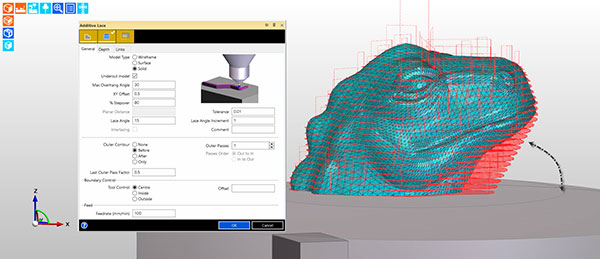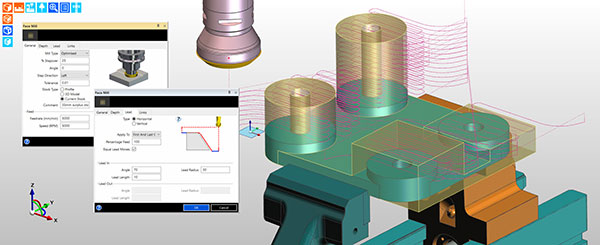
Image courtesy of Hexagon.
Latest News
January 21, 2020
The latest release of SURFCAM from Hexagon features toolpath associativity for the face mill cycle, the option to extend the solution’s parallel lace toolpath, enhanced additive undercutting and about 30 updates.
Additionally, the optional CAD for CAM Designer module has now replaced Part Modeler. From model design to part repair and modification, SURFCAM Designer is said to be the solution for taking geometry through to manufacture.
SURFCAM Designer
More than 50 enhancements have been made to Designer, including the ability to attach finishing and tolerance information to models and faces with the new “surface attributes” command. SURFCAM reads this information and applies it to the features, so it can be used in strategy decisions, or to set speed and feed rates.
Additionally, this latest version offers the new “edit boundary” command for modifying the trimming of faces directly on a sheet or solid body without having to extract any surfaces or edges. It also delivers a fresh new look and feel for the “auto-constrained surface” command, used to quickly create complex surfaces.
Additive Cycle
SURFCAM 2020.1 enhances the additive lace cycle’s “undercut” function by allowing the user to set a maximum overhang angle.

“This is necessary because different materials and processes require different negative material build-up, depending on the target shape,” Product Manager John Buehler says. “If the undercut angle is too big, it can be compensated for by using the maximum overhang angle, effectively over-ruling the angle on the part.”
Additionally, further boundary control options have been included, which mimic the same functionality of other milling cycles, allowing for greater material displacement control.
Chamfering Cycle
The new release significantly enhances the existing SURFCAM chamfering cycle with five new pieces of functionality, which are similar to those already found in the profiling cycle. Greater toolpath control is achieved with the new cut increment and Z-offset modifiers.
“Previously, if there were heavy cutting conditions, several chamfer cycles would have to be created. Now, users simply set a cut increment value, which not only results in multiple toolpath passes, but also increases tool life,” Buehler says.
Six “corner strategies” have been added, enabling programmers to choose the type of external corner condition the cycle produces. This is particularly useful when a smoother corner blend is required.
The introduction of “optimize path and lace bandwidth” modifiers reduces cycle time by determining the order in which the cycle is deployed.
Stock Enhancements
“Toolpath associativity is a vital factor when programming production components, as CAD modifications can take considerable time,” Buehler says. “SURFCAM 2020.1 removes such delays by making the face mill cycle sensitive to the stock model. When either the stock or component solid model are altered, the toolpath automatically adjusts both the X-Y and the Z height of the toolpath.”
Secondly, the lead modifier now helps increase tool life with a “horizontal” lead type, which “rolls” the cutter into the initial face of the material, reducing cutting forces.
Finish Groove Cycle
While the “pre-finish plunge” function in previous versions of the software reduced cycle times, this increased the potential for collisions, where the stock was larger than the groove feature. The new release resolves that issue by introducing a “use current stock” function, ensuring the cycle always begins higher than the current stock.
Parallel Lace: Extensions
The toolpath in the parallel lace cycle can now be extended. The function is similar to the one in the profiling cycle, which has been brought in following requests from users.
“The extensions follow the direction of the cut, and are applied in the primary direction, ‘stretching’ the toolpath, which guarantees better surface texture, an allows the cycle to cater for over-size stock,” Buehler says.
Rough Turn
An enhancement to the existing “Swarf” control command means a specific time period, in minutes, can be set, for the turning insert to be in contact with the material. Buehler says this will be particularly useful when machining hard material where there’s a requirement to control the wear rate on the insert.
The tool will return to its retract position once the time period has been reached. SURFCAM is designed to automatically put stop commands into the program, allowing the user to inspect the insert before continuing with the rest of the cut.
Tombstone Manager
The Tombstone Manager has evolved into a particularly powerful tool for production engineers working with multiple batch quantities. This latest release introduces two significant enhancements controlling the deployment of each tool, with two new “priority” functions.
“By tool then by plane” rationalizes by tool, followed by reducing indexes. Secondly, “by plane then by tool” rationalizes by plane/datum before reducing tool changes.
“Anyone wanting to use part files with multiple machining sequences will see that the general performance of the tombstone software has improved, and that sorting priorities have been enhanced,” Buehler says.
Sources: Press materials received from the company and additional information gleaned from the company’s website.
More Hexagon Manufacturing Intelligence Coverage
Subscribe to our FREE magazine, FREE email newsletters or both!
Latest News
About the Author
DE’s editors contribute news and new product announcements to Digital Engineering.
Press releases may be sent to them via [email protected].





